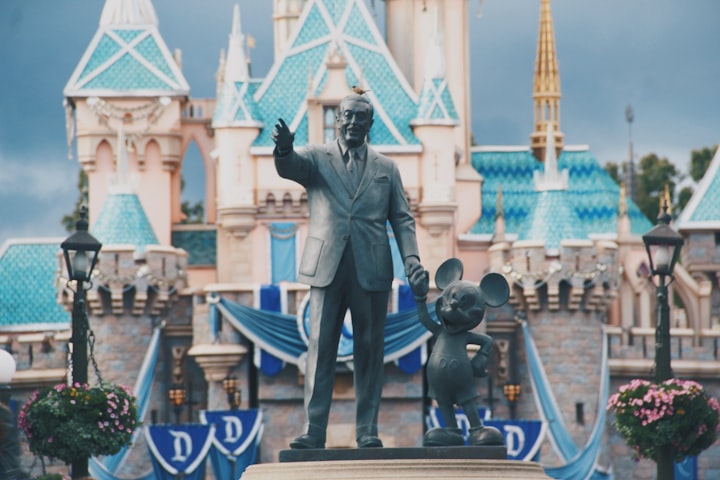
Disney has been making animated films for kids since Snow White and The Seven Dwarfs was released in 1938. Kids have been growing up with these films since then and have been looking up to characters in these movies as role models. By watching these types of movies during a young age when kids are easily influenced by the media, it is evident that these films have had an important part of the development of particular stereotypes.
Gender Roles

Snow White and The Seven Dwarfs alone explores a few gender stereotypes.
1. She becomes a housewife who would clean and cook while the dwarfs went to work, and then would act as a mother figure towards them.
2. Not only does this film show Snow White becoming a typical housewife, but in the film the dwarfs had made a deal with her to keep her safe if she would take care of the house. This details the stereotype that men are dirty and cannot be kept clean without a woman running the house.
3. Her and other princesses like Aurora and Cinderella are reliant on a man (they barely knew) to come to the rescue, which shows the damsel in distress type of stereotype. The way these men saved these three women from their troubles all had to do with romance, which pushes the idea that romance is necessary to happiness, which will be discussed later.

Disney then began to stray from those types of stereotypes and introduced a new ambitious type of princess following the women's right movement.
The Little Mermaid was the first Disney princess film to make the princess ambitious, brave, and independent. Although her entire story arc revolved around the search for true love, her character set the stage for a new wave of brave and independent Disney princesses.
Then, Mulan came out and fought gender roles. When her father was drafted into the war against The Huns as the only man in her family, Mulan left behind the girly persona that never truly fit her and decided to join the war in place of her father as a man. Mulan was the first to have a movie dedicated to breaking free from her gender defined role in society. She's not a damsel in distress, finds her true identity, and fights for the honor of her family rather than fighting specifically for love. Even though she found love along the way, it was never her main focus.

Portrayal of Love
Disney has implanted the idea that true love is always the answer by making a character's life terrible until they find the true love or by making the true love the answer. They've also used toxic relationships and turned them ideal. This is an issue because this will cause people to desire a relationship more than they desire it with a particular person. This is problematic because a relationship is not the solution to every problem in the real world.

1. Making a character's life terrible until they find true love. This is most evidently shown in Cinderella, Tangled, Aladdin and The Little Mermaid.
In Cinderella, her life consists of cleaning and being bullied by her step sisters and step mother. Once she sneaks to the ball and meets the prince, the prince finds her and they live happily ever after.
In Tangled, Rapunzel is living in her tower with a desire to escape, but it isn't until Flynn Rider shows up that she actually gets the courage to do it.
In Aladdin, Aladdin's life consisted of scrounging for scraps and stealing just to be able to survive. Jasmine was struggling to be happy with her palace life when she was tasked with finding a good suitor. When they found each other, their love was what made them able to leave the past behind.
As for The Little Mermaid, Ariel is unhappy in her life and is seeking adventure. As soon as she saves Prince Eric, she falls in love and sets out on her journey to creating her happily ever after with him.

2. True love is the answer. This can be seen in Snow White and The Seven Dwarfs, Sleeping Beauty, Cinderella, Aladdin, The Little Mermaid, and Beauty and the Beast. (This theme is also in Frozen, but it becomes more about familial love rather than romantic).
For both Snow White and The Seven Dwarfs and Sleeping Beauty, a man is needed to kiss the princess awake after they fall victim to the villain's spell. The princesses awaken and have their happily ever afters with no more issues with their respective men.
In Cinderella, Prince Charming removes Cinderella from her abusive household once they get married and she becomes a princess. This implies that Cinderella was able to successfully cut off her abusive family, never see them again, and just forget about her past because Prince Charming swooped her off her feet and took her away.
Aladdin and Jasmine were both unhappy with their lives. Then, they fell in love. Long story short, Jasmine found someone to marry and Aladdin wouldn't have to live on the streets anymore. They were able to change the law so Jasmine could marry somebody who wasn't a prince, and they lived happily ever after.
As for The Little Mermaid, her answer to her desire to explore the world above water was Prince Eric. He was why she traded her voice for legs, and once everything played out, she was able to get her happy ending.
In The Beauty and the Beast, The Beast's curse can only be lifted with true love. Belle essentially falls in love with her kidnapper to break the spell. During this time, her issues were Gaston and being the outcast of the town. When she falls in love with The Beast, they defeat Gaston and suddenly becomes princess. In this story, true love was the solution for both the prince and the princess' problems.

3. Toxic relationships exhibited in these films deemed as okay. This is seen in Cinderella and The Beauty and the Beast.
For Cinderella, she runs away from the situation and the prince decides to go on a nonviolent manhunt for her. They visit every house searching for her, after she clearly is running away from him. He doesn't know the truth behind the fairy godmother or Cinderella's true feelings at this time, all he knows is that the girl he was dancing with wanted to leave and run off. What did he do? He went door to door in search for her.
As for The Beauty and the Beast, The Beast kidnaps Belle and forces her to stay in his castle. She ends up falling in love with him anyway and they have a happily ever after.
Body Image

Body image is a huge part of the way that Disney has influenced young people. These characters are supposed to be our role models, and in their movies they're often referred to as pretty or the ideal women, like Belle (when the townspeople basically say she's weird but at least she's pretty) and Snow White (for being the fairest of them all).
These princesses all have unrealistic super slim waists and are smaller than the princes who are all muscly and fit.

In The Little Mermaid in particular, small is deemed as good and big is deemed as bad. Take a look at Ursula for example, the villain of the film, and compare her to the princess in the image above.

Ursula is basically one of the only characters with this body, and there are many people who relate to having her body more than Ariel's. She's the only character with this body, and the audience isn't supposed to like her. With no heroines without a tiny waist, it can make a young girl feel bad about having a totally normal body.
-
Disney has been improving with a lot of these stereotypes with their films like Frozen, Brave, and Moana. Those films explore female protagonists who doesn't have a love interest in their stories. The female protagonists have been going on their adventures to find their true selves without the help of a man. The solutions to their problems aren't finding romantic love.
I hope that Disney continues to grow in making films that back away from stereotypes and begin to start creating role models for young girls that won't push harmful ideals onto them.
About the Creator
Annie
she/her
I have a small sticker shop on Etsy called DynamiteArtStickers, so if you can, please check that out. The IG for it is @dynamiteart368.






Comments
There are no comments for this story
Be the first to respond and start the conversation.